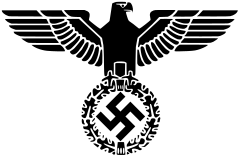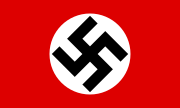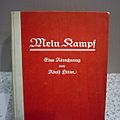Nazi Party facts for kids
Quick facts for kids
National Socialist German Workers' Party
|
|
|---|---|
 |
|
| Leader | Anton Drexler (1920–1921) Adolf Hitler (1921–1945) Martin Bormann (1945) |
| Founder | Anton Drexler |
| Founded | 1920 |
| Dissolved | 1945 |
| Preceded by | German Workers' Party (DAP) |
| Succeeded by | None (banned) Ideologies continued with neo-Nazism |
| Headquarters | Munich, Germany |
| Newspaper | Völkischer Beobachter |
| Youth wing | Hitler Youth |
| Paramilitary wing | Sturmabteilung (SA) |
| Membership | Fewer than 60 in 1920 8.5 million by 1945 |
| Ideology | Nazism |
| Political position | • Authoritarian Far-right |
| International affiliation | None |
| Colors | Black, white, red (Imperial Germany's colors); brown |
| Party flag | |
 |
|
The National Socialist German Workers' Party (Nationalsozialistische Deutsche Arbeiterpartei), often called the Nazi Party (NSDAP), was a German political party. It began in 1920, growing out of an earlier group called the German Workers' Party (DAP).
When the Nazi Party was formed, it shared a list of its main ideas. These ideas included getting rid of the Treaty of Versailles, which was a peace agreement after World War I. They also wanted more land for the German people. Other ideas involved changing the education system and creating a very strong central government. The party is most famous for being led by Adolf Hitler.
Until 1923, the Nazi Party was most popular in the German region of Bavaria.
Contents
History of the Nazi Party
In 1919, Adolf Hitler joined the German Workers' Party. In 1920, the party changed its name to the NSDAP. Hitler became its leader in 1921.
Early Attempts to Gain Power
In 1923, the Nazi Party tried to take over the government in Munich. This attempt was called the Beer Hall Putsch. It failed, and Hitler was sent to prison for a short time. The government also made the Nazi Party illegal in Germany.
While in prison, Adolf Hitler wrote most of his book, Mein Kampf (which means 'My Struggle'). In this book, he wrote down his political ideas and his plans for Germany's future.
Rise to Power Through Elections
Hitler was released from prison early in 1924. He then restarted the Nazi Party. This time, he wanted to gain power legally, through elections. At first, the Nazi Party was just one of many extreme right-wing parties in Germany. Many other parties had similar ideas. Some important business leaders, like Fritz Thyssen, supported the Nazi Party.
In the 1928 elections, the Nazi Party did not win many votes. They decided to change their approach. They focused less on anti-Jewish ideas in their public messages. Instead, they talked more about foreign policy and used fear to influence people. In local elections in 1929 and 1930, the Nazi Party started to win more votes.
In 1930, Germany's President, Paul von Hindenburg, called for new elections. The Nazi Party saw this as a chance to grow. In the elections on 14 September, 1930, the Nazi Party won 18.3% of the votes. This made them the second-largest party in Germany.
Many German people at this time wanted to get rid of the Weimar Republic, which was the government created after World War I. They also wanted a stronger Germany with a bigger army. The Treaty of Versailles had limited Germany's military power.
Taking Control of Germany
On January 30, 1933, Adolf Hitler was secretly offered the position of Chancellor of Germany. This was a "transfer of power." However, the Nazi Party later called it the "seizing of power." This made it sound like they took control by force, which was better for their propaganda.
The last "free" election in Germany was in March 1933. The Nazi Party won 44% of the vote, but this was not enough to have full control. After a major fire at the Reichstag (the German parliament building), the Nazis managed to pass a new law called the Ermächtigungsgesetz (Enabling Act). This law gave Hitler the power to do almost anything he wanted. It also made all other political parties illegal.
After this, the Nazi Party became very powerful. People often had to be party members to get certain jobs or promotions. The Nazi Party remained in control until Germany surrendered to the Allies on 8 May 1945.
Impact of the Nazi Party
The Nazi Party officially ended on 8 May 1945. After that, it no longer existed.
The Nazis made some changes that still affect laws today. For example:
- In 1934, they made a rule that when two people marry, their belongings stay separate.
- When paying taxes, people can deduct the costs of traveling to and from work.
- They made it harder for lenders to take goods from people who owed them money.
- In 1933, they created strong animal welfare and protection laws. These laws are the basis for many animal protection laws we have today.
However, the Nazis also did many terrible things. Because of this, it is now illegal in Germany to show the swastika symbol (which was on their flag) or use Nazi slogans like Sieg Heil. In 2010, a British member of the European Parliament was forced to leave after shouting a Nazi slogan at a German member.
Sayings and Slogans
Here are some common sayings and slogans used by the Nazi Party:
- "Sieg Heil! Sieg Heil! Sieg Heil!"
- This means "Hail Victory!" It was a common chant at Nazi rallies.
- "Ein Volk, ein Reich, ein Führer!"
- This means "One people, one country, one leader!"
- "Deutschland, erwache!"
- This means "Germany, Awake!" It was a popular Nazi song and was put on many banners.
- "Die Juden sind unser Unglück!"
- This means "The Jews are our misfortune!"
- "Lang lebe unser ruhmvoller Führer!"
- This means "Long live our glorious leader!"
- "Heute Deutschland, morgen die Welt!"
- This means "Today Germany, tomorrow the world!"
- "Die Deutschen immer vor dem Ausländer und den Juden!"
- This means "The German always before the foreigner and the Jews!"
- "Sicher ist der Jude auch ein Mann, aber der Floh ist auch ein Tier"
- This means "Certainly the Jew is also a man, but the flea is also an animal."
Images for kids
-
Mein Kampf in its first edition cover
-
Nazis during the Beer Hall Putsch in Munich
-
Nazi Party election poster used in Vienna in 1930 (translation: "We demand freedom and bread")
-
Reichsparteitag (Nuremberg Rally): Nazi Party leader Adolf Hitler and SA-leader Ernst Röhm, August 1933
-
Adolf Hitler in Bonn in 1938
-
Adolf Hitler and Rudolf Hess in Weimar in 1930
-
The SA in Berlin in 1932. The group had nearly two million members at the end of 1932.
See also
 In Spanish: Partido Nacionalsocialista Obrero Alemán para niños
In Spanish: Partido Nacionalsocialista Obrero Alemán para niños















